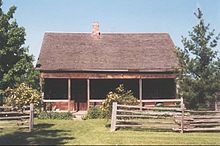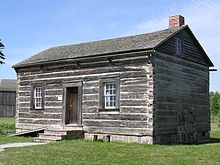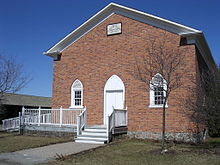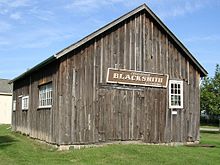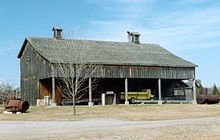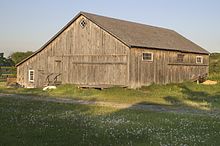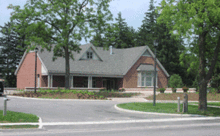- Markham Museum
-
Markham Museum 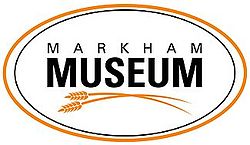
Established 1971 Location Markham, Ontario, Canada Director Town of Markham Website www.markhammuseum.ca Markham Museum (in the past known as The Markham District Historical Museum and later Markham Museum & Historic Village) is a 25-acre (10 ha) open air museum, located in Markham, Ontario, Canada. It is dedicated to the preservation of old buildings and artefacts from Markham's past, especially as a rural village has become an urban centre. The site features nearly 30 buildings: houses, barns, sheds, a train station, a school, a general store, a church, a blacksmith, a harness shop, a saw mill, a cider mill, and many more. One of the oldest buildings is the Hoover House, built in 1824 by a Mennonite family who were originally from Pennsylvania.
The site has been open since 1971, using the former Mount Joy School (1907) as its main offices and archives. The museum is located at 9350 Highway 48 (Markham Road / York Regional Road 68, on the northwest corner of 16th Avenue (York Regional Road 73).
All of the historic buildings were moved to the site from other places around Markham with the exception of the Mount Joy School. The name Mount Joy has also been preserved in the name of the nearby Mount Joy GO Transit train and bus station, as well as the Mount Joy Community Centre to the east.
In 2005, Markham Museum opened the doors on its new Reception Centre to the south of their offices.
Markham Museum is open year-round to visitors and researchers. An Ontario Historical Plaque was erected in front of the Markham Museum by the province to commemorate the founding of Markham's role in Ontario's heritage.[1]
Contents
- 1 Hours of Operation
- 2 The Site
- 3 References
- 4 External links
Hours of Operation
Victoria Day to Labour Day (Spring/Summer Season)
Monday to Friday: 10:00 a.m. to 5:00 p.m. Saturday and Sunday: 12 noon to 5:00 p.m.
Labour Day to Victoria Day (Fall/Winter Season)
Monday: Closed
Tuesday to Sunday: 12:00 p.m. to 5:00 p.m.
Closed Holidays (Special events, facility rentals, camps & pre-registered groups excepted)
The Site
There are nearly 30 buildings and structures on Markham Museum's 25-acre (100,000 m2) site, and here are a few of them:
Hoover House
History
Originally located on Lot 34, Concession 6 (present day McCowan and Stouffville Roads, Whitchurch-Stouffville) in Markham Township, this Pennsylvania Dutch Mennonite house was built in 1824 for Christian K. Hoover and his new wife, Anna Lehman. Moving to a new brick home in 1851, Christian and Anna gave this frame house to their eldest son, Abraham, at the time of his first marriage to Veronica (Fanny) Grove. The house was used by Russian Mennonite immigrants as a stopping point on their way west to Manitoba between 1873 and 1875. In the 1950s, the Hoover House was sold out of the family to Dr. Charles Williams. The house and the smokehouse behind it were then donated to the Museum in 1975.
Architecture
The Hoover House is an excellent example of a frame dwelling built c. 1824 influenced by Pennsylvania German architecture. The use of plain square wood posts supporting a steeply pitched front roof and unpainted exterior wooden walls are just some examples of the simplistic approach of the Mennonites displayed throughout the building. The 1 ½ storey home is 4 bays wide and 2 bays deep with simple wood windows having a 9 over 6 pane division on the lower level and a 6 over 6 pane division on the upper windows.
Chapman House
History
Originally located on Lot 26, Concession 5 in the hamlet of Milliken’s Corners (located at Kennedy Road and Steeles Avenue), Nathan Chapman Jr., a gentleman farmer, purchased 98 acres (400,000 m2) of land in May 1831. Born in 1810, Nathan was the son of United Empire Loyalists Nathan Chapman Sr., and Susannah Fockler, who were some of the first settlers to the area of Thornhill. The Chapman House was most likely built in 1832 around the time of Nathan’s marriage to Elizabeth Lameraux. Nathan was married a second time in 1842, after Elizabeth’s death, to Amelia Humberstone, the daughter of Thomas Humberstone who ran Humberstone Pottery in York Township. After Nathan’s death in 1892, the property and the house were left to his daughter. The house was eventually relocated to Markham Museum in 1978.
Architecture
The Chapman House is an excellent example of a regency style cottage built c. 1832. It is one of the few remaining buildings in Markham of plank-on-plank construction. The interior woodwork and trim suggests that the Chapman family had more resources to spend on such details. The house is 3 bays wide by 2 bays deep with a slightly recessed front door surrounded by decorative neo-classical trim. Louvered shutters and molded wood trim surround the wood windows which have a 12 over 12 pane division.
Maxwell House
History
Originally located on Lot 12, Concession 4 (Finch Avenue) in the Township of Scarborough, this log house was constructed by James Maxwell c. 1850. At first, James and his wife, Euphemia, operated a power grist mill as early as 1828 on the Rouge River on property south of the house site, but by 1847 their interests had changed to farming. In 1894, after James’ death, the log cabin and surrounding land was sold out of the family. The Little family, the last owners of the building, donated the cabin to the Museum in 1962, and when a suitable site was found for the home in 1970, the building was relocated to the Museum grounds.
Architecture
The structure is an example of a 1 ½ storey primitive structure constructed of timbers hewn to a square finish with traditional half-dovetail joinery. This log house is a good example of those early dwelling which dotted Markham’s rural lands and have since vanished from our agricultural landscape.
The Ninth Line Baptist Church
History
This church is an excellent example of a Gothic Revival style church building constructed in 1848. The church was originally located on 9th Line, north of Major MacKenzie Drive (just north and east of the Museum). In 1954, Hurricane Hazel went through and damaged the church. The church underwent changes through its lifetime but it did operate as a church until 1958, at which time declining numbers caused it to close. It was moved to the Museum, brick by brick, in 1981 and opened as a non-denominational church in 1982. This church is very busy in the summer months for weddings.
Architecture
Built of red clay brick, the building represents the less elaborate and more refined style of the Baptist faith. The front façade features two gothic arched windows and a central entrance with double gothic arched solid paneled doors. The 6-over-6 windows on this elevation are of a smaller size than those on the east and west sides. There is a red brick header above the windows and doors. The roof is of a low pitch with returned eaves and plain boxed cornice. A one-storey board and batten addition (not original to the building) is to the rear of the main structure. The First Baptist Church was actually dismantled brick-by-brick and reassembled on the Museum grounds. It would have been like doing a puzzle with 35,000 pieces because that’s how many bricks this structure is made of.
Wilson Variety Hall
History
Originally located in the Village of Markham, the Wilson General Store was owned and operated by Henry Wilson in the late 19th century. Born in Markham in 1835, Henry Wilson married Clementina May in 1847 and the couple had six children together. By October 1862, he and Clementina were operating a successful millinery and fancy goods store in the Village. They relocated their store to this larger building in 1875. Clementina operated the dressmaking part of the business on the second floor. In 1918 the property was sold to Dr. John MacDonald. Dismantled and reconstructed, the building was relocated to the Museum grounds in 1995.
Architecture
This front gabled store building is typical of local shops constructed in smaller villages throughout Ontario in the mid-to-late-19th century. The building is of a frame construction and the double store doors have paneled lower sections and windows above, flanked by two large store windows. Decorative posts and ornate trim characterize the store verandah. The exterior side walls are unique in that the stucco finish has been outlined to imitate stone blocks, which would have been a more expensive building material.
Locust Hill Train Station
History
Built in 1936, the Locust Hill Train Station was originally located on Lot 11, Concession 10 in the village of Locust Hill. This train station building replaced an earlier station c. 1887 that had been destroyed by fire in 1935. In 1884, the Ontario and Quebec Railway, in cooperation with the Canadian Pacific Railway, purchased land from William Button for the purpose of building a station. The first station was a two-storey building with an apartment available for the stationmaster on the second floor. In 1884, the trains began to run between Perth and Toronto, enabling Locust Hill to become a bustling village. Service through Locust Hill Station stopped in 1969 and the building was later moved to the Museum grounds in 1983.
Architecture
Based on a common plan for station buildings around 1936, this rectangular frame structure has a ticket wicket in the front square bay window where the station agent was located, a covered area for waiting passengers, and a baggage storage area at the north end.
Acadia Train Car
History
The Acadia Car was built in 1921 by the Canadian Car and Foundry Company and was put into service in 1922. At first, it was used by the Board of Railway Commissioners to transport members across Canada on railway business for the government. In 1958 it began to be used to transport other officials, dignitaries and special guests. The Acadia Car was used by Princess Margaret on her 1958 tour of Eastern Canada, by Prime Minister John Diefenbaker on his 1963 campaign trail, and by Pierre Trudeau when he was in office, before it went out of service in 1974. The Museum purchased the Acadia in 1985 and the exterior was restored in 1991.
The Transportation Building
History
Officially opened in 1989, with the permanent exhibit area completed the following year, the Transportation Building was established primarily to display the horse-drawn vehicles which had been donated by Douglas Ward. The collection was begun by Ward and his two brothers, Clifford and Frederick. From the first two horse carts purchased in 1945, the collection grew as the brothers continued to purchase carriages, sleighs, and wagons. Repairs and restorations to the vehicles were completed at the Ward farm in old Markham Township. In 1984, the forty-one vehicles were donated to Markham Museum by Mrs. Douglas Ward and these form the core of the Museum’s Transportation Collection.
Architecture
The centre front-façade section is two storeys and represents the once popular boomtown front of some Ontario buildings. It was designed to replicate the 19th century Speight Wagon Works building that was located on Main Street Markham.
The Cedar Grove Blacksmith Shop
History
This simple frame building was originally located on Lot 3, Concession 10 in the Village of Cedar Grove Markham Township. The blacksmith shop was built by Henry Lapp c. 1862 and it remained in his ownership until 1905. For the 30 years between 1866 and 1896 there was a succession of 9 blacksmiths who located their business in this building. The final blacksmith was Arthur Clendenen who first began working in this shop in 1896 and was known to be able to single-handedly put on 90 horseshoes in one day. He purchased the shop from Henry Lapp in 1905 and continued to work there for ever 60 years until 1956. In 1977, the Cedar Grove Blacksmith Shop was relocated to the Museum grounds.
The Cider Mill
History
The components of the Cider Mill came from three separate mills in three different Townships. Originally, the building itself was an old drive shed from the Lapp property at Lot 3, Concession 10. The majority of the mill’s inner-workings were obtained from the Lapp Cider Mill on Lot 5, Concession 10. This cider mill is considered to be one of the earliest and largest cider mills operating in Markham Township in the mid-to-late-19th century. All of this old mill equipment was purchased and donated to the Museum by Austin Reesor. The line shafts, through which belts drive the machinery, are a third component of the Cider Mill and these were taken from Altona Mills which was located on Lot 31, Concession 9 in nearby Altona, Pickering Township. The owner of Altona Mills, Peter Nighswander, purchased the screw press from the Stouffville Vinegar Works. The Museum rebuilt the drive shed and installed the equipment between 1981 and 1983 and the mill was fully operational in 1983 for Markham Museum’s First Annual Applefest.
The Sawmill
History
William Ratcliff emigrated from England with his wife Sarah in 1846 and eventually settled in Markham Township on Lot 35, Concession 6. By 1851, the Ratcliff family were operating a water-powered sawmill from the head of the Little Rouge River on their property. The Ratcliff sawmill was passed on through the family generations, until it ceased operation in the 1970s. In 1936, this water-powered sawmill came to be powered by a massive diesel engine. The working components of the mill and this diesel engine were moved to the Museum for safekeeping after the mill closed down in the 1970s. Unfortunately, a fire destroyed the actual mill building structure in 1982. Ashmore Reesor donated a barn for the new mill on the Museum grounds and the original Ratcliff Mill mechanical equipment was installed and made operational. Also located in the mill is additional equipment, dating from the early 20th century, which was typically used in Markham in the production of wood.
The Reception Centre
Officially opened in 2005 at the Museum's annual Applefest, this building became the new visitor entrance of the Museum. It features new exhibit space and has already housed a number of exhibits including "Passionate Vision: Intimate portraits of Canada's national parks", a photography exhibit by Canadian Astronaut and first Canadian woman in space Roberta Bondar. Other past exhibits include an exhibit about the Rwandan genocide called "We Said Never Again: The Silent Voices of Rwanda", "Space and Heroes", "e-factor: understanding alternative energies", and "On the edge: A history of hockey and skating in Markham" to coincide with the opening of Markham Museum's new outdoor skating rinks in the winter of 2006/2007.
References
- ^ "The Founding of Markham". Ontario's Historical Plaques. http://www.ontarioplaques.com/Plaques_VWXYZ/Plaque_York11.html. Retrieved 2009-05-21.
- "Markham Museum". The Town of Markham. http://www.markhammuseum.ca. Retrieved 2009-05-21.
- "Markham Museum Research Facilities". The Town of Markham. http://www.markham.ca/Markham/Attractions/Museum/research.htm. Retrieved 2009-05-21.
- Champion, Isabel (1989). Markham, 1793-1900 (2nd. ed.). Markham, Ont: Markham Historical Society. ISBN 9780969090007. OCLC 7138330. http://www.ourroots.ca/toc.aspx?id=12398&qryID=c0d41ad8-42c0-4abb-9cbd-b8387df1779a.
- Champion, Isabel; Champion, Mary B (1988). Markham remembered: a photographic history of old Markham Township. Markham, Ont: Markham Historical Society. ISBN 9780969090014. OCLC 19972630.
External links
Topics on Markham, OntarioMain topicsFounder • Government • History • Mayor • Previous Mayors • York Region (portal) • Markham municipal election, 2010 • Markham Ward 3 By-election, 2009 • Markham municipal election, 2006
TransportationCommunitiesAngus Glen • Armadale • Berczy Village • Box Grove • Buttonville • Cachet • Cashel • Cedar Grove • Cornell • Dickson Hill • Downtown Markham • Gormley • Greensborough • Legacy • Locust Hill • Old Markham Village • Markham Centre • Milliken • Mongolia • Quantztown • Unionville • Thornhill • Underwood • Vinegar Hill • Wismer Common
Education / SchoolsElementary: All Saints • Armadale • Ashton Meadows • Boxwood Public School • Castlemore • Central Park • Boxwood • San Lorenzo Ruiz • William Berczy
Secondary: Brother André • McGivney • Markham District • Markville • Middlefield • Milliken Mills • St. Augustine • St. Robert • Thornhill • Thornlea • Trudeau • Unionville
Post Secondary: Seneca College: Buttonville Airport Campus, Markham CampusAthletics, Recreation, and ShoppingAthletics: Markham Waxers • Sports
Recreation: Angus Glen Golf Club • Cedar Brae Golf & Country Club • Parks
Shopping: Markville Mall • Pacific Mall • Market VillageAttractionsMain Street Unionville • Main Street Markham • Markham Fair • Markham Museum • Markham Train Station • Thornhill Village • Varley Art Gallery
Media, and ServicesNotable PeopleBill Crothers • Brad May • Sean Morley • Ken Pereira • Tammy Sutton-Brown • Steve Thomas • Raffi Torres • Stephen Weiss • Steve Byers • Emmanuelle Chriqui • Hayden Christensen • Talan Torriero • Justin Peroff
Sister CitiesCary, North Carolina • Nördlingen, Germany • Pearland, Texas • Wuhan, China
Frederick Horsman Varley Art Gallery · Henderson Avenue Public School · IBM Canada Head Office Building · Market Village Mall · Markham Museum · Markham Stouffville Hospital · Pacific Mall · Shouldice Hernia Centre · St. Augustine Catholic High School · Thornhill Secondary School · Thornlea Secondary School · Toronto/Buttonville Municipal Airport · Toronto/Markham Airport · Unionville High SchoolCoordinates: 43°53′38″N 79°15′56″W / 43.89389°N 79.26556°W
Categories:- Buildings and structures in Markham, Ontario
- Open air museums in Canada
- Local museums in Canada
- Architectural history
- Archives in Canada
- Museums in York Region
Wikimedia Foundation. 2010.


